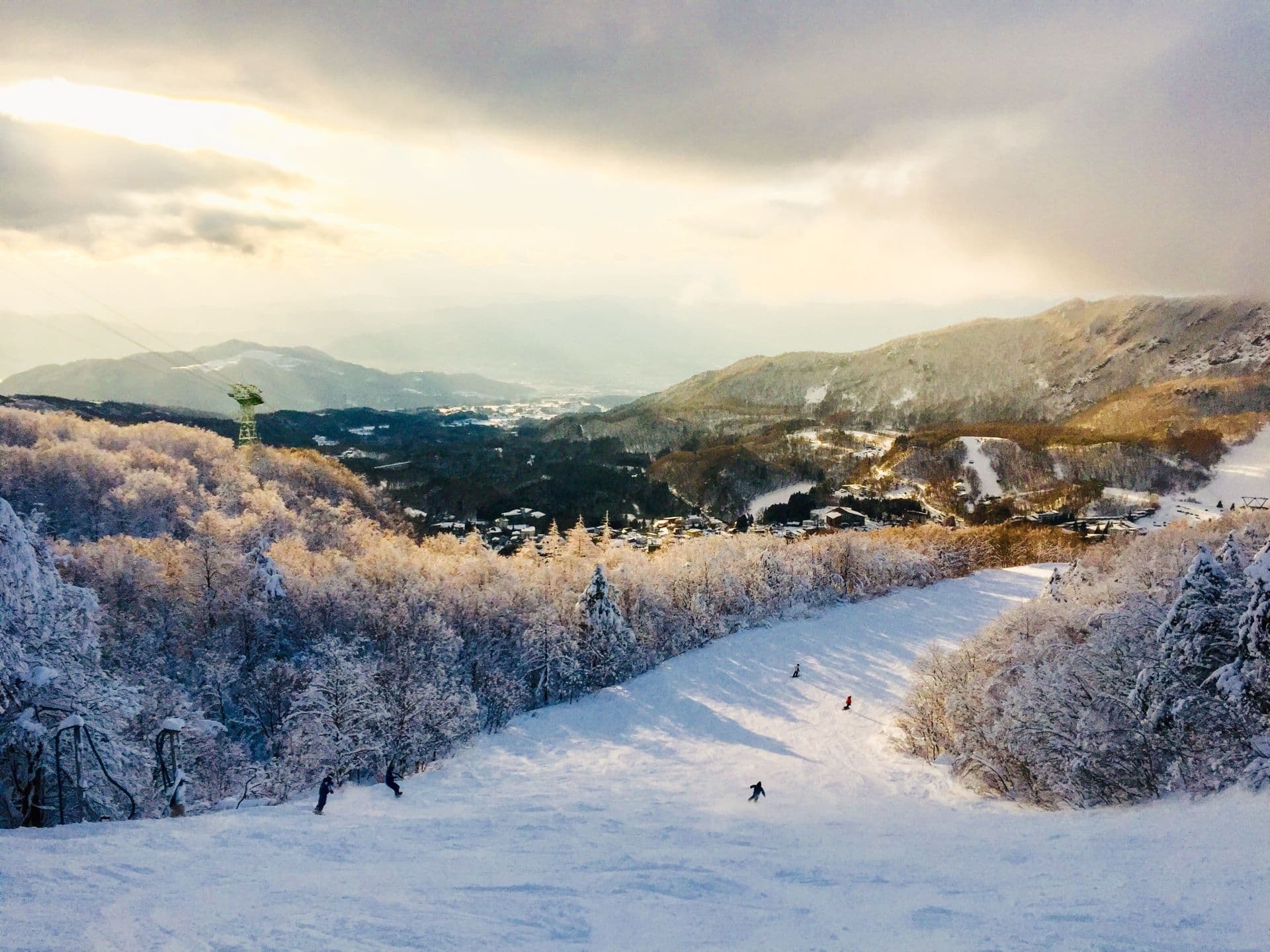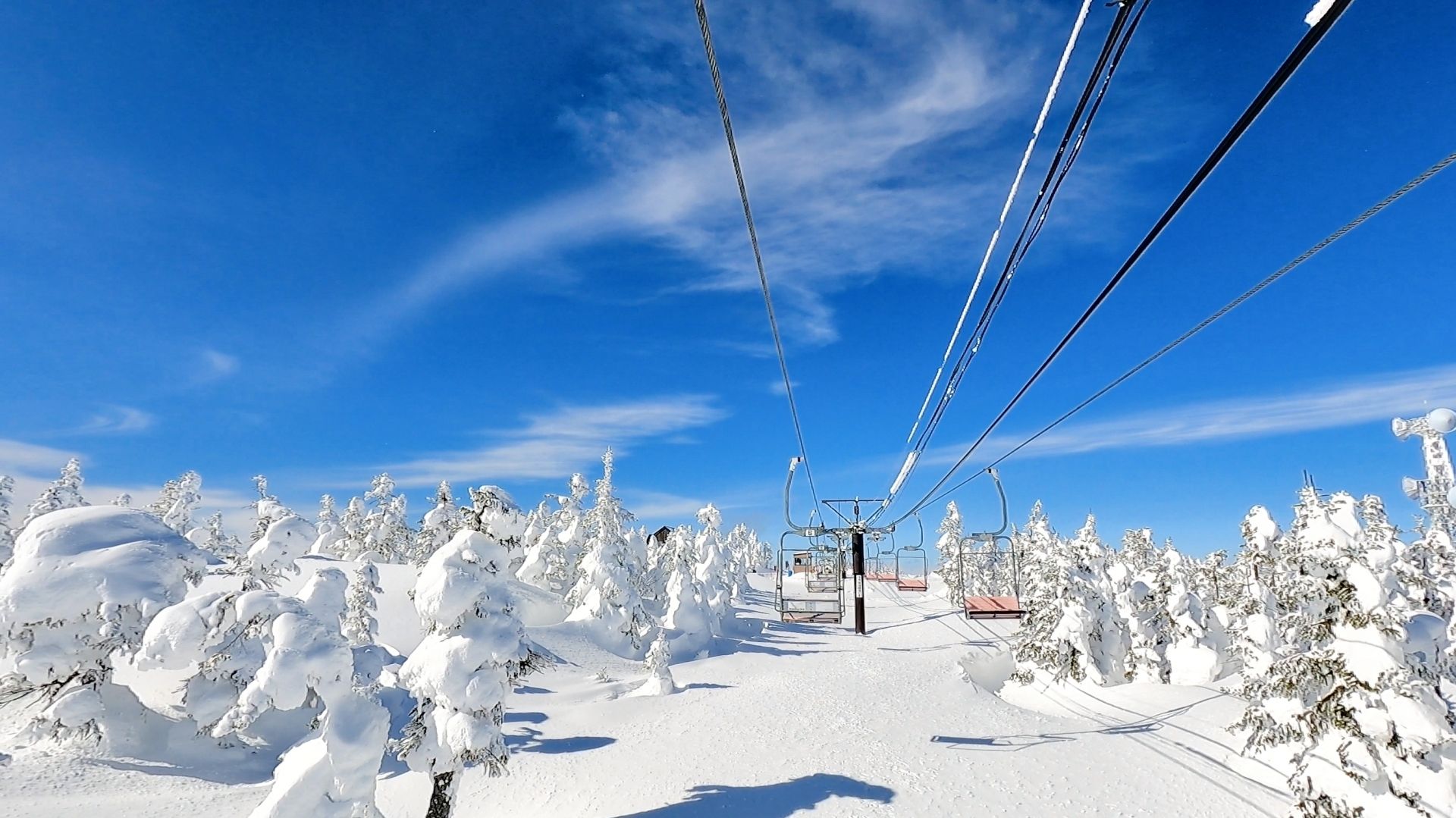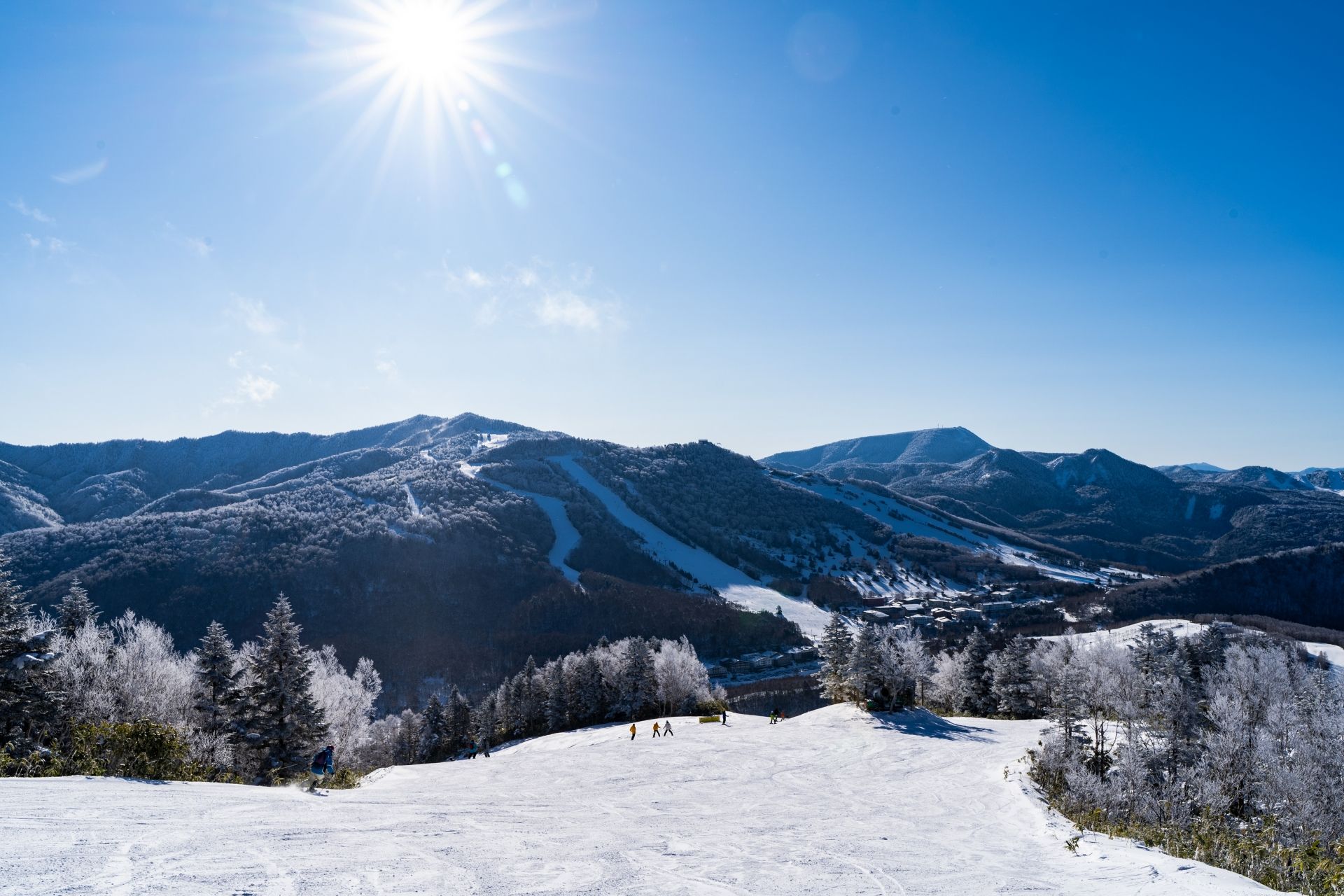Shiga Kogen
Japan’s high-alpine giant with quietly reliable pow

志賀高原
Where big mileage meets quietly excellent snow
Shiga Kogen is the definition of “big by Japan standards.” Eighteen interlinked ski areas drape across high ridgelines and broad valleys, creating that satisfying village-to-village rhythm you usually associate with Europe. The snow is classic Nagano — cold, grippy, often wind-buffed smooth up high — and the navigation is friendly once you learn the main corridors. English signage is decent, the maps are clear, and you can roam for days without repeating a route unless you want to.
This place rewards time on snow. With the top around 2,307 m and many sectors hovering well above 1,800 m, the surface stays fresh and the temperatures stay honest. Central hubs like Ichinose hum with ski schools and families, while outlying corners still feel surprisingly empty. Day one can feel colossal; by day three you’re stringing together favorite lines from Takamagahara to Yakebitaiyama to Okushiga like a local.

For pow chasers, Shiga isn’t the rowdiest backcountry-gate mecca — and that’s fine. You come here for reliable snow, meaningful vertical in tasty segments, and tree shots that hide in plain sight. When it’s puking, the upper lifts deliver light, dry cream. When it’s clear and cold, the corduroy is lightning. And when main arteries get skied out, you can still sniff out freshness in the forests and in the transitions between the big-name pods.
The vibe is distinctly Japanese: tidy base areas, low-key nightlife, lots of half-board hotels, and a handful of cozy izakaya and cafés if you poke around. Shiga was never “hidden,” but recent upgrades and better transport have nudged it onto more itineraries. Even so, midweek still feels like your own private high-alpine network.
Resort Stats
- Vertical980m (2307m → 1325m)
- Snowfall~10m
- Terrain 30% 40% 30%
- Tree Riding
- Lift Pass$52
- Lifts6 gondolas, 42 chairs
- Crowds
- Out of BoundsLimited via marked exits
- Night Skiing
- Family Friendly
- Trails84
- Skiable Area~607ha
- VibeHuge, high, quietly Japanese
Trail Map

Powder & Terrain
Shiga’s snow personality is shaped by altitude. With multiple sectors sitting high and the summit touching 2,307 m, the snow stays cold and chalky. The average sits near 10 m each winter, but the real story is how that snow rides — smoother and longer-lasting than many Nagano neighbors, especially once you move away from the central teaching hubs. Lower satellites like Maruike and Sun Valley can feel warmer; the best quality days stack up in Higashidate, Terakoya, Yakebitaiyama, and Okushiga.
The lift layout is a mixed bag in the best way. Yakebitaiyama runs two fast gondolas backed by high-speed quads; Okushiga pairs a modern gondola with swift chairs; Terakoya and Yokoteyama lean old-school with slower lifts that paradoxically protect the snow off-piste. The grand tour is real: rip a top-to-base burner off Higashidate, slide through Takamagahara and Ichinose, then push to Okushiga for colder snow and trees. Some links have flats, so boarders will want to plan traverses with a little map savvy.

Tree skiing is better than the reputation suggests. Okushiga openly embraces off-piste in bounds and is a first stop when it’s deep; Yakebitaiyama has groomed speed lines plus ungroomed pitches on the Olympic side that fill in beautifully. On storm days, start with the upper Yakebi gondola for well-bonded cream, then migrate to Okushiga as the morning rush fades. When winds bite, Terakoya’s tucked aspect holds chalky, quiet glades. Early season, bamboo lurks — wait for a proper base before pushing into tight trees.
Sidecountry exists, but it’s a “know-before-you-go” proposition. Marked gates lead to unmanaged terrain, and once you’re out there, you’re on your own. Bring avy kit, read the signage, and pick aspects with care. This isn’t the free-for-all you’ll find at certain Hokkaido resorts, but with smart hazard calls you can stack safe 300–500 m shots between pods when visibility and stability line up. Patrol will clamp down on closures, and tickets can be pulled for ducking ropes.
Crowds are kind to powder hounds. Ichinose buzzes — especially with school groups on weekends — and Yakebi draws traffic thanks to big hotels, but the sheer size of Shiga keeps lift lines sane. Midweek can feel downright empty. Even on busy days, the outlying corners and the connective ribs hold soft snow into late morning and beyond. Wind holds can happen on exposed lifts, so keep a storm-day circuit in your pocket that favors sheltered sectors and forested aspects.
Who's it for?
Mileage lovers, advanced-intermediate carvers, and pow chasers who prefer quality and elbow room to hype. Families do well with gentle zones near Ichinose and the Prince bases. If you live for long, uninterrupted steeps or a massive freeride gate network, Shiga might feel polite. But if you want consistent snow, huge on-piste variety, legit trees in the right sectors, and the freedom to roam, this highland giant delivers.
Accommodation
If you want ski-in/ski-out ease and polished logistics, the cluster of Prince Hotels at Yakebitaiyama keeps life simple: step out to the gondola, buffet breakfast, quick resets for kids, and easy early starts on storm days. It’s a tidy, family-friendly base that prioritizes time on snow over nightlife.
For a quieter, pow-first stay, Okushiga is the move. Hotels here sit right on colder, higher-elevation snow and keep the vibe mellow. Expect refined rooms, solid restaurants, a bar or lounge for a nightcap, and first crack at the trees when it’s been snowing. The whole pocket feels more remote, which is exactly the point.
Value hunters should look at Ichinose and the nearby hamlets, where pensions and simple hotels often run on half-board. It’s predictable pricing and hearty meals after big days out. If you’re chasing classic ryokan charm and onsen culture, staying down the valley in Shibu Onsen is a fun play: cobblestone lanes, multiple public baths, and easy bus links back up the hill each morning.
Food & Après
Shiga is about fueling well and riding more, not table-dancing. On-mountain cafeterias do the classics — ramen, soba, curry, katsu, and you’ll find sit-down spots tucked into hotels if you want to linger. Ichinose concentrates the most variety, from izakaya plates and hotpot to a couple of easygoing bars. Yakebitaiyama’s hotel dining is convenient but pricier; Okushiga’s hotel restaurants punch above their weight given how remote it feels. Craft beer from local breweries shows up on some lists, and there are enough cafés for a proper mid-morning coffee before you dive back into the trees.
Getting There
From Tokyo, hop the Hokuriku Shinkansen to Nagano (about 80–100 minutes), then grab the Nagaden express bus straight to Shiga Kogen (roughly 70–90 minutes, depending on your stop). Buses drop at major hubs like Ichinose and Yakebitaiyama, so you can land basically at your front door. Winter driving is totally doable, but the final ascent has steep, icy switchbacks — you’ll want winter tires or chains and some confidence in snow.
Japow Travel Tips
- Lift hours: Typically 08:30–16:30, varying by sector, daylight, and weather.
- Season length: Highest areas often run from late November into early May.
- Sidecountry rules: Gates mark exits to unmanaged terrain; carry avy kit, respect closures, and expect patrol to enforce them.
- Navigation tips: English maps/signage are good, but some links are flat — snowboarders should plan lines to minimize skating.
- Night skiing: Limited to a few pods on select nights; day + night combos usually cost a bit extra.
- Nearby options: Pair Shiga with Nozawa Onsen, Madarao/Tangram, or Ryuoo for a tasty Nagano safari.
Verdict: High, huge, and quietly premium
Shiga Kogen isn’t where you go to peacock on cliff bands. It’s where you rack up ridiculous mileage on fast cord, duck into legit trees when it’s deep, and keep finding quality snow long after breakfast. If you want big, cold, and crowd-resistant with just enough sanctioned spice — and you don’t need neon après — this highland giant will treat you right.